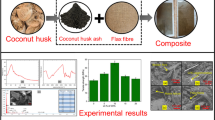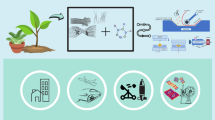Abstract
The utilization of wind power has increased almost exponentially during the last decade, leading to the growth in both the number and size of wind turbines. Modern turbine blades are typically made of fiberglass sandwiched around a balsa wood (BW) core. With an increase in the use of wind energy a collateral issue of what to do with the large and voluminous wind turbine blades (WTB) that reached end-of-life has arisen. Through previous research, we developed a recycling process that will keep these turbine blades out of the landfill by considering recycled wind turbine blades as a feedstock for second generation composite panels. The objective of this research is to further the research by understanding the effect that different compositions of wood and fiberglass have on the properties of these panels. Through testing, it was found that the addition of balsa wood increases the modulus of rupture (MOR) and the modulus of elasticity (MOE). The internal bonding (IB) strength values are well above that of typical particle board. All panels tested were visibly more resistant to water sorption than typical particle board. The thermal conductivity for all samples was within the typical range for particleboard. Fire test result indicates that the addition of balsa wood increases the heat and visible smoke release rate of composites.
Graphical Abstract








Similar content being viewed by others
Data Availability
Data will be available upon request.
References
Beauson, J., Madsen, B.: Recycling of shredded composites from wind turbine blades in new thermoset polymer composites. Compos. A. 90, 390–399 (2016)
Albers, H., Greiner, S., Seifert, H., et al.: Recycling of wind turbine rotor blades - fact or fiction? Dewi Magazine. 34, 32–41 (2009)
Larsen, K.: Recycling wind turbine blades. Renew. Energy Focus. 9(7), 70–73 (2009)
Mamanpush, S.H., et al.: Recycled wind turbine blades as a feedstock for second generation composites. Waste Manage. 76, 708–714 (2018)
Dylan, S., et al.: Recycling glass fiber thermoplastic composites from wind turbine blades. J. Clean. Prod. 209, 1252–1263 (2019)
Krzysztof, L., et al.: Recycled glass fibers from wind turbines as a filler for poly (Vinyl Chloride). Advances in Polymer Technology (2019). https://doi.org/10.1155/2019/8960503
Mamanpush, S.H., et al.: Dataset demonstrating physical properties of recycled wind turbine blade composites. Data Brief 20, 658–661 (2018)
Mamanpush, S.H., et al.: Data on the mechanical properties of recycled wind turbine blade composites. Data Brief 19, 230–235 (2018)
Mamanpush, S.H., et al.: Extruded fiber-reinforced composites manufactured from recycled wind turbine blade material. Waste Biomass Valor. (2019). https://doi.org/10.1007/s12649-019-00659-0
Mamanpush, S.H., et al.: Experimental data on the mechanical and thermal properties of extruded composites from recycled wind turbine blade material. Data Brief 25, 104253 (2019)
Mamanpush, S.H., et al.: Physical properties data of extruded composites from recycled wind turbine blade material. Data Brief (2019). https://doi.org/10.1016/j.dib.2019.104030
ASTM E1225-04:, Standard test method for thermal conductivity of solids by means of the guarded comparative longitudinal heat flow technique. (2010). https://doi.org/10.1520/E1225-04
ASTM E1354–17:. Standard test method for heat and visible smoke release rates for materials andproducts using an oxygen consumption calorimeter. (2022). https://doi.org/10.1520/E1354-22B
Wood as an engineering material:. General Technical Report FPL-GTR-190. Madison, WI: U.S. Department of Agriculture, Forest Service, Forest Products Laboratory. 508 p
Pan, Z., et al.: Physical properties of thin particleboard made from saline eucalyptus. Ind. Crops Prod. 26, 185–194 (2007)
R. H. White., K. S. Pala.: Cone calorimeter tests of wood composites. In: Forest service forest products laboratory. American Wood Council, USA (2013)
Acknowledgements
The authors gratefully appreciate the financial support by Global Fiberglass Solutions Inc. Seattle WA.
Funding
The authors have not disclosed any funding.
Author information
Authors and Affiliations
Corresponding author
Ethics declarations
Conflict of interest
The author(s) declared no potential conflicts of interest with respect to the research, authorship, and/or publication of this article.
Additional information
Publisher’s Note
Springer Nature remains neutral with regard to jurisdictional claims in published maps and institutional affiliations.
Rights and permissions
Springer Nature or its licensor (e.g. a society or other partner) holds exclusive rights to this article under a publishing agreement with the author(s) or other rightsholder(s); author self-archiving of the accepted manuscript version of this article is solely governed by the terms of such publishing agreement and applicable law.
About this article
Cite this article
Mamanpush, S.H., Li, H., Tabatabaei, B.T. et al. The Impact of Wood Fibers in Composite Panels Made from Recycled Fiberglass Wind Turbine Blades. Waste Biomass Valor 14, 2957–2964 (2023). https://doi.org/10.1007/s12649-023-02038-2
Received:
Accepted:
Published:
Issue Date:
DOI: https://doi.org/10.1007/s12649-023-02038-2




